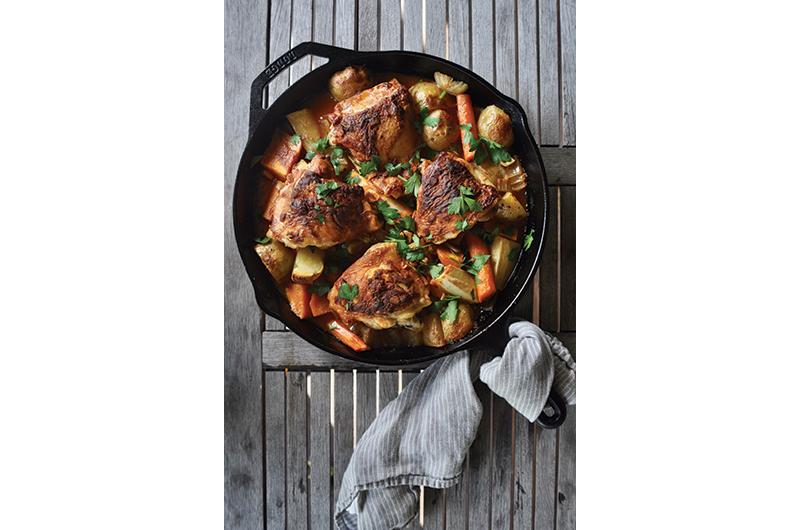To me, cold-weather cooking is all about low and slow dishes that take some time to come together but do most of the work themselves, leaving you free to tackle a trail walk, watch the game, or curl up with a good book. Braising tougher cuts of meat gently in liquid until tender is an easy and almost foolproof way to prepare such a meal. The long cooking time heats the house and fills the rooms with the enticing smell of dinner.
A big platter of tender slow-cooked meat is also a great way to feed a crowd: a modest amount of beef, chicken, pork, or lamb can easily be bulked up with plenty of vegetables to make an impressive spread. The serving is easy – almost any starch, from bread, pasta, rice, or potatoes, tastes good with a melt-in-your-mouth braise.
Even more good news for you (and your wallet): cheaper, tougher cuts of meat make the best braises. The combination of a low oven temperature and moist heat turns the well-worked muscles and connective tissues into deep broth and melty textures. Some of the best cuts to braise are beef short ribs and chuck, pork shoulder and Boston butt, lamb shoulder and shanks, and chicken thighs and legs. If you have the option of getting bone-in meat, do it: the bone adds more flavor to the pot.
We are lucky that this Island has a wide range of high quality and delicious local meat sources. Between Beetlebung Farm Meat, The Farm Institute, Good Farm, Grey Barn, Mermaid Farm and Dairy, Morning Glory Farm, Allen Farm, Pasture Prime, Ghost Island Farm, The Larder, and the West Tisbury Farmers’ Market, you can find almost any cut you’re looking for while supporting our local farmers.

Braising can take on a lot of different flavors and can be prepared in a host of ways. I like to begin the process by thinking about which cut of meat I want to use, what pot I want to cook it in (see my recommendations below), and which flavors I want to develop. Then I give my chosen cut of meat a good sear.
To do so, heat a heavy pot or Dutch oven on the stovetop and add your well-seasoned meat to it with a little oil. Brown the meat on every side. You’re aiming for a deep golden crust.
After the meat is browned, I build my flavors. Really, you can add in anything you like – vegetables, aromatics, herbs, fruits, and spices. If you’re following a beloved recipe, great! If you are winging it, great! Just make sure to pick the right veggies for the type of braise you’re preparing. Most chicken braises take only forty minutes, while large cuts of beef or pork can take more than six hours. For those longer cooking times, you’ll want to pick vegetables that can hold up under all-day cooking, such as parsnips, potatoes, onions, carrots, and winter squashes. If you want a delicate or leafy veggie in there too (like peas or spinach), you can always add it in toward the end of the cooking time.
With so many delicious variations, it’s hard to go wrong. This being the holiday season, I hope you will consider braising something to add to your table. I can guarantee your friends and family will love it and you will find the whole process easy and stress-free.
Crock Pot or Slow Cooker
Cooking meat in a slow cooker is a popular option because it is so simple. Just load it up, turn it on, and forget about it. The only thing that will remind you that dinner is cooking is the intoxicating smell wafting out of the kitchen. If you work outside the home or want to get out of the house, using a slow cooker is the safest option. Choosing a slow cooker also frees up your stove and burners for other recipes if needed, and allows you to make a big batch of a given recipe (say, pot roast or pork taco filling) to freeze for future use.
Dutch Oven
Tending to a roast in the oven on a dark, cold day can be therapeutic and relaxing, but you need to be home for six to seven hours while the oven is on, and you need to be careful not to let the meat dry out. Slow cooking a cut of meat in a Dutch oven (placed in the oven, not on the stovetop) works really well from a technique point of view as many cooks believe the surrounding heat makes for more moist and tender meat. You can sear and braise the meat in the same pan on the stovetop, which is handy from a cleanup and flavor perspective.
Roasting Pan or Cast Iron Skillet
Of course, a classic roasting pan also works well to slow cook meat and poultry. The trick is to make sure the cut of meat is submerged in enough liquid to flavor and tenderize it. There’s no lid, so be mindful of liquid overflowing and splattering. A large cast iron skillet placed in the oven is a nice choice for braising chicken because the ingredients typically fit neatly. I like to prepare chicken braises on weeknights, especially if the dish is assembled ahead of time and just needs to be popped into the oven.
The following recipe was originally published along with this article:
Braised Dijon Chicken with Root Vegetables






